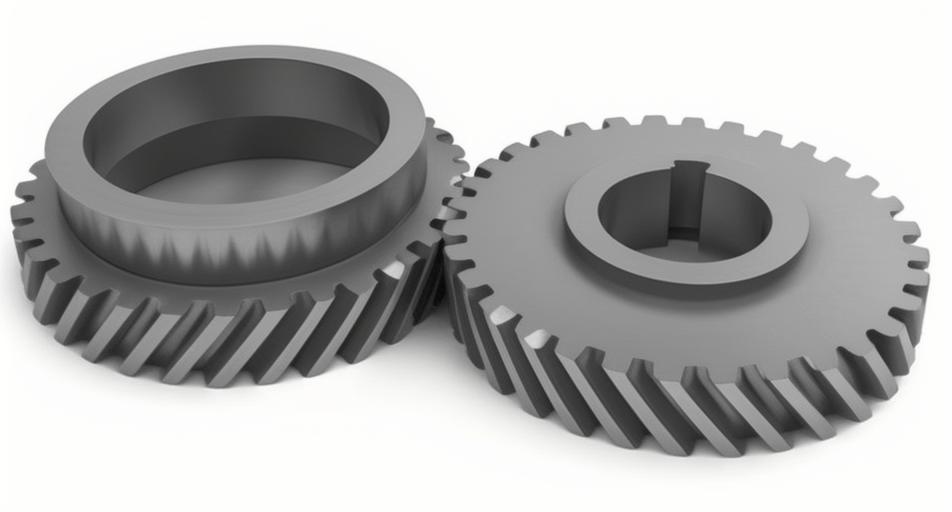
Lubrication plays a crucial role in the performance and lifespan of helical gear. Proper lubrication reduces friction, wear, and heat generation, thereby enhancing the efficiency and longevity of helical gear. This article delves into the impact of lubrication on helical gear, exploring the types of lubricants, their benefits, and best practices for lubrication management.
Importance of Lubrication in Helical Gear
- Reduction of Friction:
- Lubricants create a thin film between the contact surfaces of helical gear teeth, reducing metal-to-metal contact and thus minimizing friction.
- Lower friction results in smoother helical gear operation and reduced energy losses.
- Wear Protection:
- Proper lubrication forms a protective layer that prevents direct contact between gear teeth, reducing wear and extending gear life.
- Additives in lubricants, such as anti-wear agents and extreme pressure additives, further enhance wear protection.
- Heat Dissipation:
- Lubricants absorb and dissipate the heat generated during helical gear operation, preventing overheating and thermal damage.
- Effective heat dissipation maintains the structural integrity and performance of helical gear.
- Corrosion Prevention:
- Lubricants with corrosion inhibitors protect gear surfaces from rust and corrosion, especially in harsh environments.
- This protection is vital for maintaining the durability and reliability of helical gear.
Types of Lubricants for Helical Gear
- Mineral Oils:
- Widely used due to their affordability and availability.
- Suitable for general industrial applications with moderate load and temperature conditions.
- Synthetic Oils:
- Offer superior performance in extreme conditions, including high loads and temperatures.
- Provide better oxidation stability and longer service life compared to mineral oils.
- Greases:
- Used in applications where liquid lubricants may not be practical.
- Provide excellent adhesion and stay in place, offering long-term lubrication.
- Solid Lubricants:
- Include materials like graphite and molybdenum disulfide.
- Used in environments where liquid lubricants may evaporate or degrade.
Benefits of Proper Lubrication
- Increased Efficiency: Reduces energy losses due to friction, leading to improved operational efficiency.
- Extended Gear Life: Minimizes wear and corrosion, significantly extending the lifespan of helical gear.
- Reduced Maintenance Costs: Lowers the frequency of maintenance and replacements, reducing overall operational costs.
- Enhanced Performance: Ensures smooth and reliable helical gear operation, essential for high-precision applications.
Best Practices for Lubrication Management
- Regular Inspection and Maintenance:
- Schedule regular inspections to check lubricant levels and conditions.
- Replace or top up lubricants as needed to maintain optimal performance.
- Proper Lubricant Selection:
- Choose the appropriate lubricant based on helical gear type, load, speed, and operating environment.
- Consult manufacturer recommendations and industry standards.
- Cleanliness and Contamination Control:
- Ensure that lubricants are free from contaminants, which can cause abrasion and wear.
- Use proper storage and handling techniques to maintain lubricant purity.
- Monitoring and Analysis:
- Implement oil analysis programs to monitor lubricant condition and detect potential issues early.
- Analyze parameters such as viscosity, contamination levels, and additive depletion.
Case Study: Lubrication Impact on Industrial Helical Gear
Application: High-load conveyor system in a manufacturing plant.
Challenges: The conveyor system operates continuously under heavy loads, requiring effective lubrication to prevent wear and overheating.
Solution:
- Lubricant Selection: Chose a high-performance synthetic oil with extreme pressure additives to handle the high load conditions.
- Maintenance Routine: Implemented a regular lubrication schedule and oil analysis program to monitor lubricant condition and performance.
- Contamination Control: Installed filters and breathers to prevent contamination and maintain lubricant purity.
Results:
- Efficiency: Achieved a 10% reduction in energy consumption due to lower friction.
- Gear Life: Extended helical gear lifespan by 25%, reducing the need for frequent replacements.
- Maintenance: Reduced maintenance costs by 20% through fewer breakdowns and repairs.
- Performance: Improved overall system reliability and operational efficiency.
Table: Comparison of Lubricant Types for Helical Gear
| Feature | Mineral Oils | Synthetic Oils | Greases | Solid Lubricants |
|---|---|---|---|---|
| Cost | Low | High | Moderate | Moderate to High |
| Performance | Moderate | High | High | High |
| Temperature Range | Limited | Wide | Wide | Very Wide |
| Oxidation Stability | Moderate | High | High | High |
| Load Capacity | Moderate | High | High | High |
| Application | General Industrial | Extreme Conditions | Specific Environments | Extreme Environments |
List: Key Considerations for Lubrication Management
- Load and Speed Requirements: Assess the load and speed conditions of helical gear to select the appropriate lubricant.
- Operating Environment: Consider environmental factors such as temperature, humidity, and contamination risks.
- Manufacturer Recommendations: Follow the gear and lubricant manufacturer’s guidelines for optimal performance.
- Regular Monitoring: Implement a routine for monitoring and analyzing lubricant condition to ensure ongoing effectiveness.
- Contamination Control: Use filters and proper storage techniques to prevent contamination and maintain lubricant quality.
Conclusion
Lubrication is a critical factor in the efficiency and longevity of helical gear. By reducing friction, wear, and heat generation, proper lubrication enhances gear performance and extends their lifespan. The selection of appropriate lubricants, regular maintenance, and effective contamination control are essential practices for maximizing the benefits of lubrication.
Industries that rely on helical gear for their operations can achieve significant improvements in efficiency, reliability, and cost savings through proper lubrication management. By staying informed about the latest advancements in lubrication technology and best practices, manufacturers and operators can ensure the optimal performance and durability of their helical gear systems.
